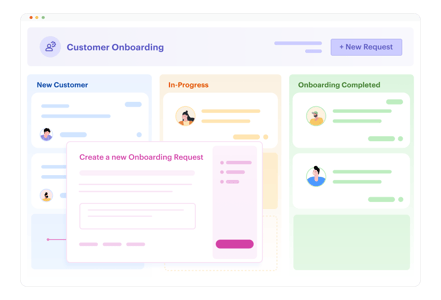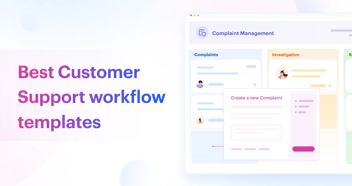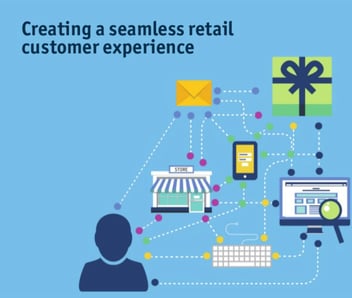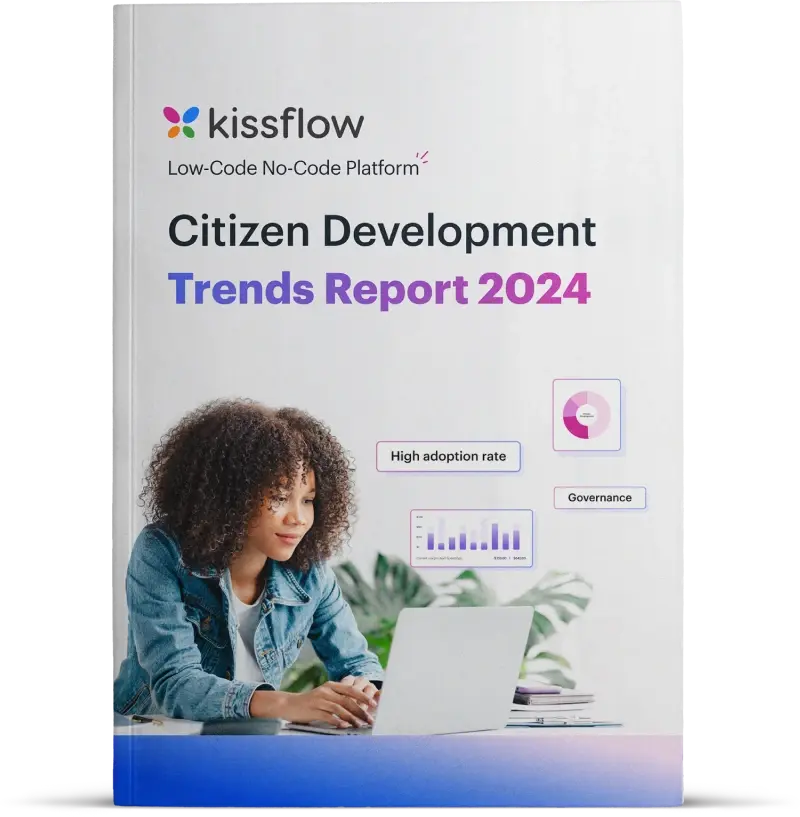
- >
- Workflow Platform >
- The Ultimate Guide to Customer Onboarding
The Ultimate Guide to Customer Onboarding
Team Kissflow
Updated on 24 Sep 2024 • 6 min read
While it takes great marketing to attract, engage, and convert your ideal prospects into customers, beyond that, your revenue operations aren’t done yet. To retain these customers you’ve acquired, you must educate them on what problem your product is supposed to solve, how it’s supposed to work for them, and why they should stay with your product/service offering after they’ve signed up.
And there’s a name for that. Customer onboarding.
What is Customer Onboarding?
Customer onboarding is the process of introducing new customers to your company, the particular product/service offering they signed up for, and educating them on how your product/service offering is designed to solve their problem.
Customer onboarding simplifies your customers’ journey by:
-
bridging the gap between customer acquisition and customer retention,
-
educating new customers on the why, what, and how of your product/service offerings work, and,
-
giving the customer a clearer picture of what to expect from your product/service offerings.
Put together, all these factors contribute to lower churn so you can focus more on growing your user base vs. struggling to acquire new customers month on month.
Here’s your complete guide on customer onboarding—the what, the why, and how it works—essentially, all you need to know to give your customers a delightful transition to using your products.
Why is customer onboarding essential?
Customer onboarding serves as the ideal avenue for introducing new customers to your brand and product/service offerings, as well as the solution your product is supposed to offer to their problems. Here are the key reasons why customer onboarding is critical to your revenue operations and overall business success.
-
Customer onboarding introduces customers to your product/service offerings, brand, your solution methodology, and essentially why your business exists.
Far from just a string of welcome emails that tell your customer how the product works, customer onboarding shows your customer the place of the product in their lives and their place in your product’s story.
Once you can successfully get your customers to see themselves in your product’s big picture and vice versa, they’re more inclined to continue using your product, thanks to a strong emotional connection.
-
Educates customers on how your product works
One of the biggest reasons why customers churn is that they just don’t understand how your product works and they decided to jump along to another solution they can get started with right away. Here’s where customer onboarding comes into the picture.
With a well-designed customer onboarding process, you can break down the key points of your product functionality to new users so they can have a smoother transition getting used to your solution.
-
Answers questions customers may have
Before signing up for your product or service offering, your customers had goals they were trying to achieve. And since they eventually signed up, that points to the fact they expect your product to meet that need.
It’ll suffice to say that once a new customer is signed up, they’ll be eager to try out whatever feature it is that they signed up for or just have their questions around that pain point answered.
Customer onboarding fills this need nicely and provides an avenue to answer FAQs that’ll help your customers gauge whether your product is the right fit for them.
With an intelligently-designed customer onboarding strategy, you can educate your customers on how your product fits their needs at that critical moment when they’re trying to learn more or just move on.
Put together, customer onboarding simplifies the customer conversion process that takes new customers from freshly signed-up to committed users growing with your business.
Who is responsible for customer onboarding?
Like with all business processes, a key factor for operating successfully is identifying who exactly is responsible for outcomes and what role they play in the bigger picture.
Here’s a breakdown of the key personas in your organization’s customer onboarding and the roles they perform.
Customer Success Manager
The customer success manager is the customer experience chief responsible for charting a course of what the customer onboarding strategy should look like, what it should cover, how it’s designed to work, and the outcomes it’s designed to generate.
The customer success manager creates a 360-degree overview of the organization’s customer onboarding strategy and consults with higher executives to factor their considerations into action.
Customer Experience Manager
Similar to the customer success manager, the customer experience manager is responsible for:
-
measuring key metrics across the customer onboarding process to see what’s working, what’s not, and what could be improved,
-
engaging with customers to record their observations, suggestions, etc.,
-
communicating the needs of customers to higher executives and especially, the product team, and,
-
assisting the customer success manager in designing and executing a customer onboarding strategy.
Chief Executive Officer
As the pointsman for the entire organization, the CEO gets a say regarding every decision and deliberation the customer success and customer experience management bring up. Along with the rest of the executive team, the CEO weighs major customer onboarding decisions alongside how they’ll affect other parts of the organization and then decides on what’s going to be moved ahead with.
Overall, the entire organization at large has a huge role to play in the onboarding picture.
Benefits of Customer Onboarding
Intelligent customer onboarding gives customers more reasons why they should stay with your business, driving revenue and brand popularity through the roof.
Here are other reasons why you should take a more definite stance toward your customer onboarding.
Decreased churn rate
Your churn rate is the measure of how much of your customers drop out of the funnel after signing up for your product or service offerings. It helps you track how effective your retention is and how fast you can grow your business. This simply means that a greater churn rate equals that you’re investing heavily in marketing and acquisition but seeing little growth out of it.
When you can onboard customers more effectively, you reduce your churn rate and make it easier to grow your customer base at a significant pace.
Increased LTV
The lifetime value of a customer is a measure of how much revenue you’re able to get from a single customer for the period they stay with your business. With a decreased churn rate, your customers spend more time with your business giving you a stable revenue, which over time, grows into a solid lifetime value.
Improved customer experience and brand evangelism
When you’re constantly working to give new customers the best onboarding experience possible, not only will you maintain a lower than average churn rate, you’ll discover that you end up with a huge base of raving fans who are eager to spread the word about your product without any formal compensation agreement.
This is simply because when users have been searching for solutions for a while and your product shows up and offers a perfect answer with as few hoops as possible to jump through, it’s logical that they’ll only be too eager to spread the word about their great experience.
Lower customer acquisition costs and a sustainable growth rate
Customer acquisition and customer retention are two sides of the same coin, both aimed at driving long-term revenue for your organization. What follows is that if you manage to retain just a fraction of your customers, you’ll always be scrambling to attract and convert new leads month on month.
On the other hand, if you perfect a customer onboarding strategy that helps you retain a significant number of the customers you attract, it’s possible to spend less on acquiring new customers yet grow at a sustainable rate.
Steps to design and implement a customer onboarding process
Judging by the number of customers you have, it’s going to be impossible to manually onboard every one of them.
Instead, what you need is an automated customer onboarding process for acquainting any new customers with your product/service once they carry out a specific action.
Here’s the step-by-step guide and best practices to designing and running a customer onboarding process that scales with ease.
-
Define your targets, i.e., what are the outcomes you’re looking to achieve from running this customer onboarding process? Decrease churn? Increase LTV? Clearly defining what you plan on getting done with a customer onboarding process makes it easier to know when exactly you’ve achieved your goals.
-
Define the metrics you’ll use for tracking your outcomes. Whether it’s the churn rate or customer LTV, definite metrics make it easier to know how well you’re performing.
-
Choose the channels you will offer onboarding content, materials, or collateral from. This could be in-app messages or pop-ups, email drips, social media, etc.
-
Choose and create the library of content you’ll offer new customers such as a knowledge base where emails will be linked, immersive product walkthroughs, videos, email content, etc.
-
Organize the onboarding content into a sequence that’ll be fed to the customer at definite time gaps.
-
Choose a process management tool to control everything from
-
Design your process in your chosen process management tool, including automation to trigger the sequence of actions so you won’t have to manually carry out tasks for thousands of customers.
-
Launch.
-
Periodically track metrics from your onboarding process or campaign to see how well you’re doing.
Customer Onboarding Made Simple
Try Kissflow's Customer Onboarding Template for Free.
Conclusion
In conclusion, customer onboarding is too critical an issue to be left alone or not sufficiently attended, judging by the fact that it can determine how fast your business grows.
Likewise, it’s helpful to admit that you can’t run your customer onboarding manually. Even if you had just a handful of new customers weekly, you wouldn’t be able to guarantee a uniform onboarding experience and as a result, it’d be impossible to track your results.
So, what do you do?
Use a process management tool to plan, design, launch, and automate your customer onboarding.
Kissflow Process offers:
-
intuitive process design that’s easy to set up with zero technical knowledge,
-
smart automation that syncs with other tools you use and can be triggered when new customers take a specific action,
-
tasks, so you can assign specific parts of the process to members of your team, and
-
dashboards, for tracking key metrics right in one place,
Take Kissflow Process for a spin here.
Customer Onboarding shouldn't be a struggle!
Related Articles












